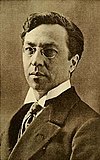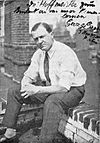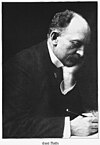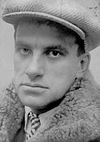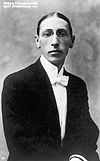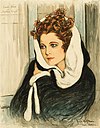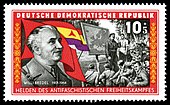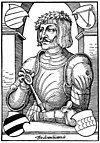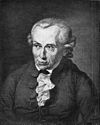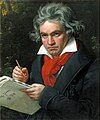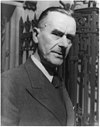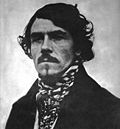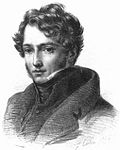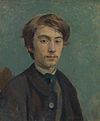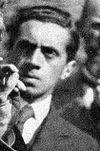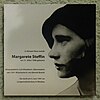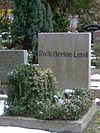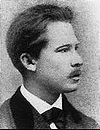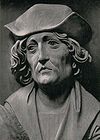Artist in the "Aesthetics of Resistance"
The multitude of artists in the "Aesthetics of Resistance" , which Peter Weiss incorporated into his novel The Aesthetics of Resistance , form a kind of musée imaginaire (imaginary museum) with more than a hundred named artists and as many works of art , mainly the visual arts and the literature , but also the performing arts and music .
List of artists
The following list is a supplement to the list of works of art in the "Aesthetics of Resistance" and contains around one hundred names of artists who are discussed, named, enumerated or included in detail in the novel. They are largely arranged in the order in which they appear in the book. Exceptions are motifs which, after a brief mention, are given a more detailed description on later pages. By clicking on the arrow in the table headings, the list can be sorted differently; a detailed description of the sorting options can be found after the table .
| Illustration / chronology | Artist / origin | Work / classification | In the novel |
|---|---|---|---|
|
Max Ernst 1891–1976 painter |
Fine arts / person |
listed as an example: in the ranking of some modern painters, especially Surrealism and Dadaism , whose pictures attacked social and political conditions and in which “lightning-like illumination of fermentation and rot, panic and upheaval” could be seen. |
|
|
Paul Klee 1879–1940 painter |
Fine arts / person |
listed as an example: in the ranking of some modern painters, especially Surrealism and Dadaism , whose pictures attacked social and political conditions and in which “lightning-like illumination of fermentation and rot, panic and upheaval” could be seen. |
|
|
Wassily Kandinsky 1866–1944 painter |
Fine arts / person |
listed as an example: enumerated in the list of some modern painters, especially Surrealism and Dadaism , whose pictures attacked social and political conditions and in which "lightning-like illumination of fermentation and rot, panic and upheaval" could be seen. Kandinsky is also mentioned in the novel as one of the painters about whose artistic revolution Leon Trotsky had spoken. |
|
|
Kurt Schwitters 1887–1948 painter |
Fine arts / person |
listed as an example: in the ranking of some modern painters, especially Surrealism and Dadaism , whose pictures attacked social and political conditions and in which “lightning-like illumination of fermentation and rot, panic and upheaval” could be seen. |
|
|
Salvador Dalí 1904–1989 painter |
Fine arts / person |
listed as an example: in the ranking of some modern painters, especially Surrealism and Dadaism , whose pictures attacked social and political conditions and in which “lightning-like illumination of fermentation and rot, panic and upheaval” could be seen. |
|
|
René Magritte 1898–1967 painter |
Fine arts / person |
listed as an example: in the ranking of some modern painters, especially Surrealism and Dadaism , whose pictures attacked social and political conditions and in which “lightning-like illumination of fermentation and rot, panic and upheaval” could be seen. |
|
|
Otto Dix 1891–1969 painter |
Fine arts / person |
listed as an example: In the ranking of some modern painters, here in particular the New Objectivity , whose pictures attacked the social and political conditions and "reproduced the disintegration objectively and precisely" . Culture and politics grew together until 1933: "It was the entire atmosphere of vitality, unlimited imagination, and the joy of experimentation that made up cultural life." |
|
|
George Grosz 1893–1959 painter |
Fine arts / person |
listed as an example: In the ranking of some modern painters, here in particular the New Objectivity , whose pictures attacked the social and political conditions and "reproduced the disintegration objectively and precisely" . Towards the end of the novel, the idea is rounded off with his example, among other things. Culture and politics grew together until 1933: "It was the entire atmosphere of vitality, unlimited imagination, and the joy of experimentation that made up cultural life." |
|
|
Lyonel Feininger 1871–1956 painter |
Fine arts / person |
listed as an example: In the ranking of some modern painters, whose pictures attacked the social and political conditions and whose pictures "sharply dissected and measured the existing reality" . The idea is taken up again in the discussion of Picasso's Guernica. |
|
|
Emil Nolde 1867–1956 painter |
Fine arts / person |
listed as an example: in the ranks of some modern painters whose pictures attacked social and political conditions and "made reality flare up hotly" . Towards the end of the novel, the idea is rounded off with his example, among other things. Culture and politics grew together until 1933: "It was the entire atmosphere of vitality, unlimited imagination, and the joy of experimentation that made up cultural life." |
|
|
Oskar Kokoschka 1886–1980 painter |
Fine arts / person |
listed as an example: in the ranks of some modern painters whose pictures attacked social and political conditions and "made reality flare up hotly" . |
|
|
Max Beckmann 1884–1950 painter |
Fine arts / person |
listed as an example: in the ranks of some modern painters whose pictures attacked social and political conditions and "made reality flare up hotly" . Towards the end of the novel, the idea is rounded off with his example, among other things. Culture and politics grew together until 1933: “It was the entire atmosphere of vitality, unlimited imagination, and the joy of experimentation that made up cultural life.” But the turning away from this idealism is also questioned. Beckmann belonged to the left veristic wing of the New Objectivity, his works were ostracized by the National Socialists as "degenerate", and he himself succeeded in emigrating in 1937. At a lecture in 1938 he maintained a strict separation between spirit and politics and stated that he would never have been politically active. |
|
|
Jean-François Millet 1814–1895 painter |
Fine arts / person |
discussed or mentioned: With the discussion of some of Millet's paintings, his personal background is also included and the question is asked whether his origins as a farmer's son reveal a certain resistance potential in his pictures. |
|
|
Vladimir Mayakovsky 1893–1930 writer |
Literature / Person |
discussed or mentioned: The protagonists take Mayakovsky in particular as an example of the upheaval in the cultural conception of the Soviet Union and the suppression of expressionist statements by Stalinism: "Mayakovsky (...) with his suicide anticipated the disaster that is now spreading over the Soviet state." |
|
|
Kasimir Malewitsch 1879–1935 painter |
Fine arts / person |
listed as an example: in a series of artists whose expressionist statements were suppressed in the early Soviet Union and in particular by Stalinism: "Why was an art that was revolutionary denied and ostracized, (...) why was a narrow limit on the capacity to be absorbed when a Mayakovsky, Blok , Bednij, Jesenin and Bely , a Malewitsch, Lissitzki , Tatlin , Wachtangow, Teirow , Eisenstein or Vertow had found the language that was identical to a new universal consciousness. " |
|
|
James Joyce 1882–1941 writer |
Literature / person |
listed as an example: in a series of artists whose art could change social existence : "We insisted that Joyce and Kafka, Schönberg and Stravinsky, Klee and Picasso belong to the same series in which Dante was also." |
|
|
Franz Kafka 1883–1924 writer |
Literature / Person |
discussed or mentioned: enumerated in a list of artists whose art could change social existence : "We insisted that Joyce and Kafka, Schönberg and Stravinsky, Klee and Picasso belong to the same series that Dante was in." |
|
|
Arnold Schönberg 1874–1951 composer |
Music / Person |
listed as an example: in a series of artists whose art could change social existence : "We insisted that Joyce and Kafka, Schönberg and Stravinsky, Klee and Picasso belong to the same series in which Dante was also." |
|
|
Igor Stravinsky 1882–1971 composer |
Music / Person |
listed as an example: enumerated in a series of artists whose art could change social existence : "We insisted that Joyce and Kafka, Schönberg and Stravinsky, Klee and Picasso belong to the same series that Dante was in." |
|
|
Pablo Picasso 1881–1973 painter |
Fine arts / person |
discussed or mentioned: enumerated in a series of artists whose art could change social existence : “We insisted that Joyce and Kafka, Schönberg and Stravinsky, Klee and Picasso belong to the same series that Dante was in.” |
|
|
Dante Alighieri 1265–1321 poet and philosopher |
Literature / person |
discussed or mentioned: enumerated in a series of artists whose art could change social existence : “We insisted that Joyce and Kafka, Schönberg and Stravinsky, Klee and Picasso belong to the same series that Dante was in.” |
|
|
Carola Neher 1900–1942 actress |
Performing arts / person |
discussed or mentioned:
in the context of the protagonists' discussion of the Stalinist purges in the Soviet Union, Neher's arrest in July 1936 and indictment in the Moscow trials . |
|
|
Sergei Eisenstein 1898–1948 director |
Performing arts / person |
content included: Example of a list of cultural contributions about Soviet film in the Arbeiter Illustrierte (AIZ): “It introduced many of us to the problems of art, literature and science. What the great (...) films Eisenstein, Pudowkins , Ekks , Vertow had suggested was continued in the picture . " |
|
|
Willi Bredel 1901–1964 writer |
Literature / Person |
discussed or mentioned: Example in a list of contemporary workers' writers: "In the books by Kläber , Gotsche , Hoelz , Bredel, Marchwitza or Neukrantz , we encountered proletarian reality, between gloomy, gray exhaustion and open struggle." |
|
|
Friedrich Hölderlin 1770–1843 poet |
Literature / Person |
discussed or mentioned: List and comparison of some personalities in German cultural history: “It was not the insights of Hölderlin, his Hellenism, this disguise of the spirit of the French Revolution (...) that had become effective in the nature of the Germans, but the Germanizing chauvinism of Fichte. (...) This disproportion between the titans, these pillars of the authorities, who denied the people common sense and the right to independence and recommended them to obey, and revolutionary, ostracized, outcast figures like Forster , Kleist , Grabbe , Büchner , Heine never allowed the development of humanism in Germany. " |
|
|
Johann Gottlieb Fichte 1762–1814 philosopher |
Literature / person |
discussed or mentioned: List and comparison of some personalities in German cultural history: "It was not the insights of Hölderlin, his Hellenism, this disguise of the spirit of the French Revolution (...) that had become effective in the essence of the Germans, but the Germanizing chauvinism of Fichte." |
|
|
Ulrich von Hutten 1488–1523 humanist |
Literature / person |
discussed or mentioned: List and comparison of some personalities in German cultural history: "(...) how the enlightened, rational Hutten was ousted by the folk-like Luther" . |
|
|
Martin Luther 1483–1546 theologian |
Literature / person |
discussed or mentioned: List and comparison of some personalities in German cultural history: "(...) how the enlightened, rational Hutten was ousted by the folk-like Luther" . |
|
|
Johann Gottfried Herder 1744–1803 poet |
Literature / person |
discussed or mentioned: List and comparison of some personalities in German cultural history: "(...) the sober scientific Herder was ousted by the soulful, idealistic Goethe" . |
|
|
Johann Wolfgang von Goethe 1749–1832 poet |
Literature / person |
discussed or mentioned: List and comparison of some personalities in German cultural history: "(...) the sober scientific Herder was ousted by the soulful, idealistic Goethe" . |
|
|
Immanuel Kant 1724–1804 philosopher |
Literature / person |
discussed or mentioned: List and comparison of some personalities in German cultural history: "(...) the dry Kant, who limited himself to human experience, was pressed against the wall by the metaphysical Hegel." |
|
|
Georg Wilhelm Friedrich Hegel 1770–1831 philosopher |
Literature / person |
discussed or mentioned: List and comparison of some personalities in German cultural history: "(...) the dry Kant, who limited himself to human experience, was pressed against the wall by the metaphysical Hegel." |
|
|
Richard Wagner 1813–1883 composer |
Music / Person |
discussed or mentioned: List and comparison of some personalities in German cultural history: "This (...) is the reason for the fascist mass psychosis that wrapped itself in the sounds of Wagner and abused Beethoven." |
|
|
Ludwig van Beethoven 1770–1831 philosopher |
Music / Person |
discussed or mentioned: List and comparison of some personalities in German cultural history: "This (...) is the reason for the fascist mass psychosis that wrapped itself in the sounds of Wagner and abused Beethoven." |
|
|
Thomas Mann 1875–1955 writer |
Literature / Person |
discussed or mentioned: Mention of the development from a liberal author to an opponent of the fascist dictatorship and a debate about his relationship between art and politics. |
|
|
Francisco de Goya 1746–1828 painter |
Fine arts / person |
discussed or mentioned: Francisco de Goya and especially his work is discussed several times in the course of the novel. It is first mentioned in the first-person narrator's ideas of the country and republic of Spain through memories of "Goya's Caprichos and Desastres, of poems by Lorca, of images from a surrealist film by Buñuel." |
|
|
Federico García Lorca 1898–1936 writer |
Literature / Person |
discussed or mentioned: The first-person narrator's ideas of the country and republic of Spain are shaped by memories of "Goya's Caprichos and Disastres, of poems by Lorca, of images from a surrealist film by Buñuel." |
|
|
Luis Buñuel 1900–1983 director |
Performing arts / person |
discussed or mentioned: The first-person narrator's ideas of the country and republic of Spain are shaped by memories of "Goya's Caprichos and Disastres, of poems by Lorca, of images from a surrealist film by Buñuel." |
|
|
Aeschylus 525-456 BC BC poet |
Literature / Person |
discussed or mentioned: He is mentioned as a role model for a protagonist in the Spanish Civil War: “In politics, in the art of the possible, there is no room for feelings, and also in the art of the impossible, which encompasses our emotions, our sense of form, our poetic sense, now has to stand everything under the sign of the necessary. (...) Our role model is Aeschylus, who went into the field heavily armed. " |
|
|
Eugène Delacroix 1798–1863, painter |
Fine arts / Person |
discussed or mentioned: Reflections on the personal background with which Delacroix painted the dispute in Paris in 1830: “Up until now he had sent his extravagant fantasies into hell and carnage (...) now he was trying to give shape to this July day, in which he was raging . Driven by idealism and arrogance, which was part of the feeling of uselessness that sometimes overshadowed his life, he wanted to participate in the unstoppable force that urged change. " |
|
|
Théodore Géricault 1791–1824, painter |
Fine arts / Person |
discussed or mentioned: Examination of the painter's personal background: “Likewise, Géricault's vision emerged from a haunted, disturbed life in which the instability, the constant flight from oneself initially found expression in the military campaigns and the collapse of the Napoleonic empire, in broad and violently painted martial ones Scenes, later in wild horses. " |
|
|
Vincent van Gogh 1853–1890 painter |
Fine arts / person |
discussed or mentioned: Several sections of the novel deal with Van Gogh's oeuvre, especially within the depiction of an imaginary scene in which the protagonists encounter the artist in Montmartre: |
|
|
Émile Bernard 1868–1941 painter |
Fine arts / Person |
discussed or mentioned: Mentioned in an imaginary scene of the encounter with Van Gogh in Café Tambourin in Montmartre. |
|
|
Henri Rousseau 1844–1910 painter |
Fine arts / person |
discussed or mentioned: Description of the legendary banquet in the Bateau-Lavoir in 1908, which was celebrated on the occasion of the sale of a painting by Rousseau. The representation in the novel is stylized like a self-portrait of the painter. |
|
|
Hans Arp 1886–1966 painter and poet |
Fine arts / person |
discussed or mentioned: List of artists who stood up for a revolting art: “Living between international newspapers and magazines, between leaflets, manifestos, traveling emissaries, the inventions of a Cravan , Picabia , Duchamp , Arp, Apollinaire had entered us, nobody could say From where we had obtained the openness for such experimentation, the explanation was perhaps only that our senses had been sharpened by all the humiliations and chastisements. " |
|
|
Ernst Toller 1893–1939 writer |
Literature / Person |
discussed or mentioned: Depictions of the life of Toller and the debate about his political impact and his suicide after numerous personal setbacks and the defeat in the Spanish Civil War. He killed himself because he saw no political way out. "All his work was an accusation against the disempowerment of the individual, (...) he had to let himself be ground up, and in his defenselessness he was more honest than the others who hide behind restraint." |
|
|
Carl von Ossietzky 1889–1938 writer and journalist |
Literature / Person |
discussed or mentioned: Report by Rosalinde von Ossietzky , the daughter of Carl von Ossietzky, who is included as the protagonist in the novel, about the persecution and death of her father. |
|
|
Bertolt Brecht 1898–1956, writer |
Literature / Person |
discussed or mentioned: Extensive discussion about the person and the artist Bertolt Brecht in Swedish exile. |
|
|
Helene Weigel 1900–1971 actress |
Performing arts / person |
discussed or mentioned: Shown in a scene in the garden of the house in Lindigö, where the "Brechtian extended family" lived in exile until the end of 1939. |
|
|
Margarete Steffin 1908–1941 writer, actress |
Literature / person |
discussed or mentioned: Shown in a scene in the garden of the house in Lindigö, where the "Brechtian extended family" lived in exile until the end of 1939. |
|
|
Ruth Berlau 1906–1974 actress |
Performing arts / person |
discussed or mentioned: Shown in a scene in the garden of the house in Lindigö, where the "Brechtian extended family" lived in exile until the end of 1939. |
|
|
Diego Velazquez 1599–1660 painter |
Fine arts / Person |
discussed or mentioned: listed as court painter whose pictures were exhibited in the Pardo Palace |
|
|
Carl Fredrik Hill 1849–1911 painter |
Fine arts / person |
listed as an example: listed as an example of a Swedish artist who was misunderstood by his time, driven into madness: "This city, in which your reason is to be strangled by the philistines, in which you should perish between the lukewarm, the lazy." |
|
|
Ernst Josephson 1851–1906 painter |
Fine arts / person |
listed as an example: listed as an example of a Swedish artist who was misunderstood by his time, driven into madness: "This city, in which your reason is to be strangled by the philistines, in which you should perish between the lukewarm, the lazy." |
|
|
August Strindberg 1849–1912 writer |
Literature / person |
listed as an example: listed as an example of a Swedish artist who was misunderstood by his time, driven into madness: "This city, in which your reason is to be strangled by the philistines, in which you should perish between the lukewarm, the lazy." |
|
|
Alexander Girardi 1850–1918, actor |
Performing arts / Person |
discussed or mentioned: listed during the extensive enumeration of Brecht's library as a statement by Brecht who could not part with a book about Girardi's life: “His Torelli, in the Singspiel artist's blood, (...) must have been Kafka's model when characterizing the painter Titorelli, in the process. " |
|
|
Karin Boye 1900–1941 writer |
Literature |
discussed or mentioned: The writer is the protagonist in the third part of the novel and influences the development of the first-person narrator as a writer in a field of tension contrasted with Brecht. Her last months in Alingsås and her suicide are also portrayed. |
|
|
Elisabeth Schumacher 1904–1942 graphic artist |
Fine Arts / Person |
discussed or mentioned: Elisabeth Schumacher is named several times in the novel with her story in the resistance, her artistic work is not listed. |
|
|
Oda Schottmüller 1905–1943 dancer and sculptor |
Performing arts / Person |
discussed or mentioned: Multiple mentions in the novel. The depiction in a scene of the execution of the members of the Red Orchestra on August 5, 1943 and further murders of resistance fighters against National Socialism is haunting, as described choreographically like a dance of death. |
|
|
Kurt Schumacher 1905–1942 sculptor |
Fine Arts / Person |
discussed or mentioned: Multiple mentions, especially his farewell letter, in which he comforted himself, "the sculptor saw himself next to Riemenschneider, Veit Stoss and Jörg Ratgeb, who were all drawn into the people's wars with their art." |
|
|
Tilman Riemenschneider 1460–1531 sculptor |
Fine arts / Person |
discussed or mentioned: The sculptor mentioned by Kurt Schumacher in his suicide note was arrested and tortured after his involvement in the peasant wars. |
|
|
Jerg Ratgeb 1480–1526 sculptor |
Fine arts / person |
discussed or mentioned: Kurt Schumacher includes the sculptor in his farewell letter. |
|
|
Veit Stoss 1447–1533 sculptor |
Fine arts / person |
discussed or mentioned: The sculptor mentioned by Kurt Schumacher in his suicide note was branded with red-hot iron on both cheeks after being charged with forgery of documents. |
|
|
Hilde Rubinstein 1904–1997 painter and poet |
Fine arts / Person |
discussed or mentioned: Mentioned alongside many other listed artists who had wandered the streets and were looking for opportunities for their artistic work in Swedish exile. |
Sorting options
The artists listed here are largely arranged in the order in which they appear in the book. By clicking the arrow in the table headings, the list can be sorted differently as follows:
- The artists listed can be sorted in the order of their years of birth using the Figure / Chronology column .
- The names of the artists can be displayed in alphabetical order.
- The artists can be sorted according to their field of work using the Work / Classification column :
- Visual arts
- performing Arts
- literature
- music
- The page numbers listed in this column under the abbreviations AEdW I to III refer to the paperback edition, which is paginated according to volumes.
- With the column In the novel the entries can be sorted according to their meaning within the novel:
- discussed in detail
- discussed or mentioned
- listed as an example
- content included (in this case the work is not explicitly named, but results from the context)
literature
- Peter Weiss: The Aesthetics of Resistance. Frankfurt (Main) 1988, ISBN 3-518-11501-4 , Volumes I to III
- Alexander Honold, Ulrich Schreiber (Ed.): The world of images of Peter Weiss. Argument special volume new series Volume 227, Hamburg 1995, ISBN 3-88619-227-X
Web links
- Klaus Müller-Richter: Peter Weiss and the journey of images. On the research situation (PDF; 180 kB), accessed on May 16, 2010
- Michael Hofmann: Is there an "aesthetic of resistance" shaped by Hinduism? , accessed on May 16, 2010
Individual evidence
- ↑ Nana Badenberg: The "Aesthetics" and their works of art. An inventory ; in: Alexander Honold, Ulrich Schreiber (ed.): The world of images of Peter Weiss , Hamburg 1995, ISBN 3-88619-227-X , p. 115
- ↑ a b The page numbers refer to the Suhrkamp paperback edition (es 1501): Peter Weiss, Die Ästhetik des Resistance , Frankfurt (Main) 1988, ISBN 3-518-11501-4 , volumes I to III, which is paginated in volumes. In the following, this reference is abbreviated in footnotes with AedW and corresponding to volumes I to III.
- ↑ AedW I, p. 79
- ↑ AedW II, p. 57
- ^ A b Nana Badenberg: Annotated Directory , p. 194
- ^ Nana Badenberg: Annotated Directory , p. 167
- ↑ AedW I, p. 184
- ↑ a b AedW I, p. 347
- ^ Nana Badenberg: Annotated Directory , p. 176
- ^ Nana Badenberg: Annotated Directory , p. 183 ff.
- ↑ AedW II, p. 35
- ↑ AedW II, p. 38; Nana Badenberg: Annotated Directory , p. 220
- ↑ AedW II, p. 55; Nana Badenberg: Annotated Directory , p. 166
- ↑ AedW II, p. 173
- ↑ AedW II, p. 144
- ^ Nana Badenberg: Annotated Directory , p. 228
- ^ Nana Badenberg: Annotated Directory , p. 229
- ↑ a b AedW I, p. 281
- ^ Nana Badenberg: Annotated Directory , p. 192
- ^ A b Nana Badenberg: Annotated Directory , p. 223
- ↑ AedW I, p. 233
- ↑ AedW III, p. 214


